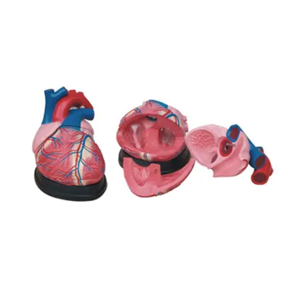

Article tag: Anatomical heart model| Anatomical organ model| BIX-A1067|
Cardiac anatomy model plays a vital role in medical education, especially in improving students' medical skills. Through the study of 3D models, students are able to more intuitively and comprehensively understand the anatomical structure and physiological function of the heart, so as to perform more skillfully and confidently in clinical practice. Co...
In medical education, cardiac anatomy models are widely used in anatomy courses, clinical skills training and professional knowledge teaching. With the continuous improvement of teaching quality in the medical field, how to effectively improve medical skills has become the focus of educators and students. As an important teaching tool, cardiac anatomy model can provide intuitive and in-depth learning experience for medical students.

The teaching role of cardiac anatomical models
As one of the teaching models, the anatomical model of the heart usually shows the various parts of the heart, including the atria, ventricles, heart valves, and large blood vessels, in a highly reproduced three-dimensional structure. These models can help medical students to fully understand the anatomy of the heart and become familiar with its physiological function through hands-on operation, disassembly, assembly, etc.
According to experts in the education industry, cardiac anatomy models have significant advantages in improving medical skills. Using a three-dimensional model of heart anatomy helps students understand complex physiological and anatomical concepts more intuitively than traditional book learning. Through practical observation and touch, students are able to better grasp the heart structure, thereby improving their operational skills and clinical judgment.
Data support: Effects of cardiac anatomy models on skill improvement
According to data from a 2023 survey, more than 75% of medical students who use cardiac anatomy models for learning believe that model teaching helps them better understand the anatomy of the heart and feel more confident when applying this knowledge in clinical practice. In addition, 82 percent of teachers surveyed said that using a heart anatomy model was effective in enhancing students' hands-on skills and spatial imagination.
Specifically, in heart surgery training, cardiac anatomy models are used to help trainees train for surgical operations, allowing them to accumulate experience in simulated operations. These simulations not only enhance students' hands-on skills, but also improve their overall understanding of heart structure and function. More than 90 percent of medical students believe that using a cardiac anatomy model helps them better understand complex surgical steps and effectively reduces the error rate during actual surgery.
Relationship between cardiac anatomical models and clinical skills
The use of cardiac anatomy models is not limited to basic education, but also plays an increasingly important role in clinical skills training. In the clinical training of cardiovascular specialty, students need to master the skills of cardiac operation and disease diagnosis, and the cardiac anatomical model is the basis of these skills training. By simulating heart surgery and dissection, students can practice and improve their hands-on skills without harming the patient.
Industry experts point out that the cardiac anatomy model is of great significance to the clinical skills of the trainees. Through the "model to patient" learning process, students will not only be able to master the fundamentals of the heart, but will also be able to quickly apply this knowledge in clinical work, thereby improving work efficiency and accuracy.
Summary
Cardiac anatomy model plays a vital role in medical education, especially in improving students' medical skills. Through the study of 3D models, students are able to more intuitively and comprehensively understand the anatomical structure and physiological function of the heart, so as to perform more skillfully and confidently in clinical practice. Combined with data support and technology development, the teaching effect of cardiac anatomy model will be further enhanced, providing strong support for medical education and professional skills improvement. As technology continues to innovate, cardiac anatomy models will play an increasingly important role in medical education in the future.